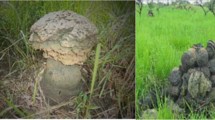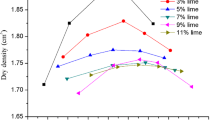Abstract
Limestone powder produced by mechanical crushing of quarried rocks to usable sizes is a by-product, which has been studied as an alternative additive material for stabilising mechanical behaviour of a low plastic silt. Use of such application can reduce the amount of waste limestone powder, thereby reducing the environmental impact from disposal into landfills. The low plastic silt mixed by adding 0%, 5%, 10%, 20%, 30%, 40%, and 50% of dry limestone powder has been characterized by means of various laboratory tests, including fall cone, unconfined compressive strength (UCS), California Bearing Ratio, and one-dimensional consolidation test. The testing results indicated a substantial decrease in Atterberg’s limits, increment in strength, and a decrease of its deformability with limestone powder addition in the silt. The specimens tested in UCS were cured for 0, 7, 14, and 28 days. This results in a reduction of about 25% in thickness of flexible pavement with limestone powder treated subbase layers. Evidently, the optimum content of limestone powder used appears to be about 30% of the total powder content in mixtures tested.





















Similar content being viewed by others
References
Akbarimehr D, Eslami A, Aflaki E (2020) Geotechnical behaviour of clay soil mixed with rubber waste. J Clean Prod 271:122632
ASTM D1557-12e1 (2012) Standard test methods for laboratory compaction characteristics of soil using modified effort (56,000 ft-lbf/ft3 (2,700 kN-m/m3)). ASTM International, West Conshohocken, PA
ASTM D854–14 (2014a) Standard test methods for specific gravity of soil solids by water pycnometer. ASTM International, West Conshohocken, PA
ASTM D4546–14e1 (2014b) Standard test methods for one-dimensional swell or collapse of soils. ASTM International, West Conshohocken, PA
ASTM D2166/D2166M-16 (2016a) Standard test method for unconfined compressive strength of cohesive soil. ASTM International, West Conshohocken, PA
ASTM D1883–16 (2016b) Standard test method for California Bearing Ratio (CBR) of laboratory-compacted soils. ASTM International, West Conshohocken, PA
ASTM D5084-16a (2016c) Standard test methods for measurement of hydraulic conductivity of saturated porous materials using a flexible wall permeameter. ASTM International, West Conshohocken, PA
ASTM D4318–17e1 (2017a) Standard test methods for liquid limit, plastic limit, and plasticity index of soils. ASTM International, West Conshohocken, PA
ASTM D6913/D6913M-17 (2017b) Standard test methods for particle-size distribution (gradation) of soils using sieve analysis. ASTM International, West Conshohocken, PA
ASTM D2435, D2435M-11 (2020) Standard test methods for one dimensional consolidation properties of soils using incremental loading. ASTM International, West Conshohocken, PA
Attom M, Al-Sharif M (1998) Soil stabilization with burned olive waste. Appl Clay Sci 13:219–230
Brooks R, Asce F, Udoeyo FF, Asce AM, Takkalapelli KV (2011) Geotechnical properties of problem soils stabilized with fly ash and limestone dust in Philadelphia. J Mater Civ Eng 23:711–716
BS EN ISO 17892-6 (2017) Geotechnical investigation and testing - Laboratory testing of soil - Part 6: Fall cone test
Cabalar AF (2010) Applications of the triaxial, resonant column and oedometer tests to the study of micaceous sands. Eng Geol 112:21–28
Cabalar AF, Demir S (2019) Fall-cone testing of unsaturated sand-clay mixtures. Proc Inst Civ Eng-Geotech Eng 172(5):432–441
Cabalar AF, Hasan RA (2013) Compressional behaviour of various size/shape sand–clay mixtures with different pore fluids. Eng Geol 164:36–49
Cabalar AF, Karabash Z (2019) Influence of cement type and sample preparation on the small-strain behaviour of sands. Arab J Sci Eng 44:8835–8848
Cabalar AF, Mustafa WS (2017) Behaviour of sand–clay mixtures for road pavement subgrade. Int J Pavement Eng 18(8):714–726
Cabalar AF, Abdulnafaa MD, Karabash Z (2016) Influences of various construction and demolition materials on the behavior of a clay. Environ Earth Sci 75(9):841
Cabalar AF, Hassan DI, Abdulnafaa MD (2017) Use of waste ceramic tiles for pavement subgrade. Road Mater Pavement Design 18(4):882–896
Cabalar AF, Demir S, Khalaf M (2021) Liquefaction resistance of different size/shape sand-clay mixtures using a pair of bender element–mounted moulds. Journal of Testing and Evaluation, Published ahead of print, 01 January 2021. https://doi.org/10.1520/JTE20180677
Carrera A, Coop M, Lancellotta R (2011) Influence of grading on the mechanical behaviour of Stava tailings. Géotechnique 61(11):935–994
Cokca E, Yazici V, Ozaydin V (2009) Stabilization of expansive clays using granulated blast furnace slag (GBFS) and GBFS-cement. Geotech Geol Eng 27:489–499
Ekundayo OI, Adepehin J (2017) Alternative approach to clay stabilization using granite and dolerite dusts. Geotech Geol Eng 35:1657–1664
Ene E, Okagbue C (2009) Some basic geotechnical properties of expansive soil modified using pyroclastic dust. Eng Geol 107:61–65
Eslami A, Akbarimehr D (2021) Failure analysis of clay soil-rubber waste mixture as a sustainable construction material. Constr Build Mater 310:125274
Feng TW (2001) A linear log d log w model for the determination of consistency limits of soils. Can Geotech J 38(6):1335–1342
Hansbo S (1957) A new approach to the determination of the shear strength of clays by the fall-cone test. Proc Roy SGI 14:7–48
HD 26/06 (2006) Pavement design and maintenance-foundations, volume 7, design manual for roads and bridges (DMRB). Part 3. The Stationery Office, London
Horpibulsuk S, Phetchuay C, Chinkulkijniwat A, Cholaphatsorn A (2013) Strength development in silty clay stabilized with calcium carbide residue and fly ash. Soils Found 53:477–486
Kalkan E (2011) Impact of wetting–drying cycles on swelling behavior of clayey soils modified by silica fume. Appl Clay Sci 52:345–352
Kang X, Ge L, Kang GC, Mathews C (2015) Laboratory investigation of the strength, stiffness, and thermal conductivity of fly ash and lime kiln dust stabilised clay subgrade materials. Road Mater Pavement Des 16:928–945
Ke L, Takahashi A (2012) Strength reduction of cohesionless soil due to internal erosion induced by one-dimensional upward seepage flow. Soils Found 5(4):698–711
Kolay PK, Ramesh KC (2016) Reduction of expansive index, swelling and compression behavior of kaolinite and bentonite clay with sand and class C fly ash. Geotech Geol Eng 34:87–101
Kumar B, Sharma R (2007) Volume change behavior of fly ash-stabilized clays. J Mater Civ Eng 19:67–74
Lade PV, Liggio CD Jr, Yamamuro JA (1998) Effects of non-plastic fines on minimum and maximum void ratios of sand. Geotech Test J 21(4):336–347
Li PP, Brouwers HJH, Chen W, Yu Q (2020) Optimization and characterization of high-volume limestone powder in sustainable ultra-high performance concrete. Constr Build Mater 242:118112
Likos WJ, Jaafar R (2014) Laboratory fall cone testing of unsaturated sand. J Geotech Geoenviron Eng 140(8):04014043
Melton J, Clark C, Regis P (2012) Feasibility study on building-derived concrete debris for use in highway construction. In: Testing and specification of recycled materials for sustainable geotechnical construction. ASTM International
Mohanty S, Pradhan P, Mohanty C (2016) Consolidation and drainage characteristics of expansive soil stabilized with fly ash and dolochar. Geotech Geol Eng 34:1435–1451
Monkul MM, Ozden G (2007) Compressional behavior of clayey sand and transition fines content. Eng Geol 89:195–205
Ni Q, Tan TS, Dasari GR, Hight DW (2004) Contribution of fines to the compressive strength of mixed soils. Geotechnique 54(9):561–569
Ogila WAM (2016) The impact of natural ornamental limestone dust on swelling characteristics of high expansive soils. Environ Earth Sci 75:1493
Okagbue C, Onyeobi T (1999) Potential of marble dust to stabilise red tropical soils for road construction. Eng Geol 53:371–380
Pastor JL, Tomás R, Cano M, Riquelme A, Gutiérrez E (2018) Evaluation of the improvement effect of limestone powder waste in the stabilization of swelling clayey soil. Sustainability 11:679
Phanikumar B, Sharma R (2004) Effect of fly ash on engineering properties of expansive soils. J Geotech Geoenviron Eng 130:764–767
Rahman MM, Lo SR (2008) The prediction of equivalent granular steady state line of loose sand with fines. Geomech Geoeng 3(3):179–190
Roberts FL, Kandhal PS, Brown ER, Lee DY, Kennedy TW (1996) Hot mix asphalt materials, mixture design, and construction, 2nd edn. National Center for Asphalt Technology (NCAT), Auburn University, p 603. Accession Number: 00748198
Sabat AK, Muni PK (2015) Effects of limestone dust on geotechnical properties of an expansive soil. Int J Appl Eng Res 10:37724–37730
Saygili A (2015) Use of waste marble dust for stabilization of clayey soil. Mater Sci 21:601–606
Sezer A, Inan G, Yilmaz H, Ramyar K (2006) Utilization of a very high lime fly ash for improvement of Izmir clay. Build Environ 41:150–155
Sivrikaya O, Kiyildi KR, Karaca Z (2014) Recycling waste from natural stone processing plants to stabilise clayey soil. Environ Earth Sci 71:4397–4407
Sol-Sánchez M, Castro J, Ureña CG, Azañón JM (2016) Stabilisation of clayey and marly soils using industrial wastes: pH and laser granulometry indicators. Eng Geol 200:10–17
Thevanayagam S (1998) Effect of fines on confining stress on undrained shear strength of silty sands. J Geotechn Geoenviron Eng 124(6):479–491
Thevanayagam S, Mohan S (2000) Intergranular state variables and stress–strain behaviour of silty sands. Geotechnique 50(1):1–23
Wang D, Shi C, Farzadnia N, Shi Z, Jia H (2018) A review on effects of limestone powder on the properties of concrete. Constr Build Mater 192:153–166
Zuo L, Baudet BA (2015) Determination of the transitional fines content of sand-non plastic fines mixtures. Soils Found 55(1):213–219
Author information
Authors and Affiliations
Corresponding author
Rights and permissions
Springer Nature or its licensor (e.g. a society or other partner) holds exclusive rights to this article under a publishing agreement with the author(s) or other rightsholder(s); author self-archiving of the accepted manuscript version of this article is solely governed by the terms of such publishing agreement and applicable law.
About this article
Cite this article
Cabalar, A.F., Omar, R.A. Stabilizing a silt using waste limestone powder. Bull Eng Geol Environ 82, 300 (2023). https://doi.org/10.1007/s10064-023-03302-4
Received:
Accepted:
Published:
DOI: https://doi.org/10.1007/s10064-023-03302-4




